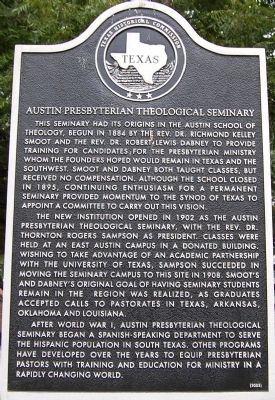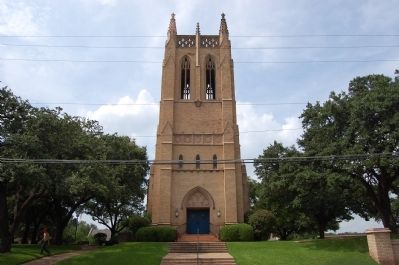Austin Presbyterian Theological Seminary
American Presbyterian and Reformed Historical Site
This seminary had its origins in the Austin School of Theology, begun in 1884 by the Rev. Dr. Richmond Kelley Smoot and the Rev. Dr. Robert Lewis Dabney to provide training for candidates for the Presbyterian ministry whom the founders hoped would remain in Texas and the southwest. Smoot and Dabney both taught classes, but received no compensation. Although the school closed in 1895, continuing enthusiasm for a permanent seminary provided momentum to the Synod of Texas to appoint a committee to carry out this vision.
The new institution opened in 1902 as the Austin Presbyterian Theological Seminary, with the Rev. Dr. Thornton Rogers Sampson as President. Classes were held at an east Austin campus in a donated building. Wishing to take advantage of an academic partnership with the University of Texas, Sampson succeeded in moving the seminary campus to this site in 1908. Smoot’s and Dabney’s original goal of having seminary students remain in the region was realized, as graduates accepted calls to pastorates in Texas, Arkansas, Oklahoma and Louisiana.
After World War I, Austin Presbyterian Theological Seminary began a Spanish-speaking department to serve the Hispanic population in south Texas. Other programs have developed over the years to equip Presbyterian pastors with training and education for ministry in a rapidly changing world.
Erected 2002 by Texas Historical Commission. (Marker Number 12743.)
Topics and series. This historical marker is listed in these topic lists: Churches & Religion • Education. In addition, it is included in the American Presbyterian and Reformed Historic Sites series list. A significant historical year for this entry is 1884.
Location. 30° 17.507′ N, 97° 44.264′ W. Marker is in Austin, Texas, in Travis County. It is in University of Texas at Austin. Marker is on West 27th Street near Wichita Street, on the right when traveling west. Touch for map. Marker is at or near this postal address: 100 W 27th Street, Austin TX 78701, United States of America. Touch for directions.
Other nearby markers. At least 8 other markers are within walking distance of this marker. Austin Presbyterian Theological Seminary Campus (a few steps from this marker); Rebecca Kilgore Stuart Red (within shouting distance of this marker); All Saints’ Episcopal Church (about 700 feet away, measured in a direct line); All Saints' Chapel (about 700 feet away); Buen Retiro (approx. 0.2 miles away); Zeta Tau Alpha House (approx. 0.3 miles away); Whitley-Keltner House (approx. 0.3 miles away); John Elbridge Hines (approx. 0.3 miles away). Touch for a list and map of all markers in Austin.
Regarding Austin Presbyterian Theological Seminary. The Seminary Chapel is one of 445 American Presbyterian and Reformed Historical Sites registered between 1973 and 2003 by the Presbyterian Historical Society (PHS), headquartered in Philadelphia. Approved sites received a metal plaque featuring John Calvin’s seal and the site’s registry number (PHS marker location unknown).
The following text is taken from the Presbyterian Historical Society website:
Shelton Chapel was designed by architect Marvin Eikenroht and built in 1941. The late Gothic Revival-style structure features pier buttresses, lancet windows, and pitched roofs. The 80-foot tower is modeled on the central tower of Canterbury Cathedral. Composed of four levels, and defined by sill lines wrapping around the corner buttresses, the tower is ornamented with shields and bosses representing Christian and Presbyterian themes. The chapel’s interior is also faithful to Gothic design, with a fixed altar attached to the rear wall, and floor-to-ceiling arches. Eikenroht designed the intricately carved wood furnishings, including the narthex screen, reredos, pulpit, pews, and chancel seats, to complement the architecture.
Credits. This page was last revised on February 1, 2023. It was originally submitted on December 23, 2009. This page has been viewed 1,032 times since then and 31 times this year. Last updated on October 29, 2020, by Richard Denney of Austin, Texas. Photos: 1, 2. submitted on December 23, 2009, by Keith Peterson of Cedar Park, Texas. • J. Makali Bruton was the editor who published this page.

